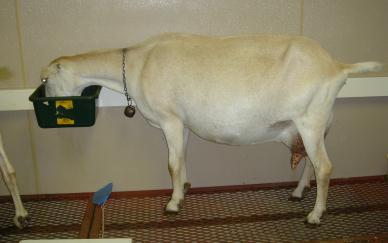

Goat Milk Facts
* Many People with cow milk allergies can drink goat milk and eat goat cheese because it 


 contains a different kind of protein. Approximately 40 % of all patients sensitive to cow milk
contains a different kind of protein. Approximately 40 % of all patients sensitive to cow milk  proteins tolerate goat milk and goat cheese.
proteins tolerate goat milk and goat cheese.
* Goat milk has 13% less lactose than cow milk, and 41% less than human milk.
* The milk fat particles/globule are small, making goat milk very easy to digest. Babies do  extremely well on goat milk formulas, when a mother does not nurse her own baby.
extremely well on goat milk formulas, when a mother does not nurse her own baby.
* Goat milk has superior ease of digestion and buffering properties, making it an ideal 
 convalescent diet for people with digestive upsets or ulcers.
convalescent diet for people with digestive upsets or ulcers.
* A powerful justification for drinking goat milk can come from medical needs, especially for  infants afflicted with various ailments, including sensitivity to cow milk.
infants afflicted with various ailments, including sensitivity to cow milk.
* Goat milk and its products, including butter, are pure white because all the yellow 
 betacarotene is already converted to colourless pure vitamin A.
betacarotene is already converted to colourless pure vitamin A.
* Compared to cows milk, goat milk has similar amounts of protein, fat, iron, vitamin C and 
 vitamin D. Coat milk has more natural vitamin A, more vitamin B and less lactose.
vitamin D. Coat milk has more natural vitamin A, more vitamin B and less lactose.
* Fresh wholesome goat milk contributes to the strong and healthy development of growing 
 children.
children.
* Goat milk and cow milk taste about the same, yet goat milk is more fragile and can obtain an 
 off flavor if improperly handled
off flavor if improperly handled
* Goat milk is higher in calcium, potassium,vitamins A and C, phosphorus, niacin, and protein 
 than cows milk.
than cows milk.
* Goat milk is lower in folacin and should be supplemented with leafy green vegetables.
* Goat milk is lower in cholesterol than either sheep or cow milk; almost 22% lower. (Cow milk 
 has 14g/100g; sheep milk has 14 g/100g; goat milk has 11 g/100g.)
has 14g/100g; sheep milk has 14 g/100g; goat milk has 11 g/100g.)
ABOUT GOAT MILK
Très Belle Chèvre
Goat Dairy & Fromagerie

Goat milk is smooth and impeccably clean and rich in flavor. America’s best chefs and cooks are adding a new dimension to familiar foods with goat milk and goat cheese.
Naturally good tasting goat milk and goat milk products are also good for you. Long considered an alternative for those with cow milk sensitivities including infants, and the infirm. Goats milk digestibility is due to smaller, naturally homogenized fats. Goats milk also has a higher percentage of short and medium chin fatty
acids than cow’s milk and is lower in cholesterol and higher in calcium, phosphorus, and vitamins A and B.
While the taste of goats milk is much like cow milk, maybe sweeter or richer tasting; the molecule composition is significantly different. The fat globules are much smaller and therefore easier to digest in the goats milk, also making the milk naturally homegenized. Cow's milk also contains a protein that many people are sensitive or allergic to, that is not present in either human or goat milk, thus making it a valuable alternate to baby formula.
Naturally Homegenized
Health Benefits
Goat milk has become of considerable interest to the medical profession, because of its easy digestibility and unique benefits in many metabolic diseases of humans.
Milk Composition
The role of milk in nature is to nourish and provide immunological protection for the mammalian young. Milk and honey are the only articles of diet whose sole function in nature is food. It is not surprising, therefore, that the nutritional value of milk is high.
Cow 3.2 3.7 4.6 66
Human 1.1 4.2 7.0 72
Water Buffalo 4.1 9.0 4.8 118
Goat 

 2.9
2.9
 3.8
3.8 
 4.7
4.7 


 67
67
Donkey
 1.9
1.9 
 0.6
0.6 
 6.1
6.1 


 38
38
Elephant 
 4.0
4.0 
 5.0
5.0
 5.3
5.3 


 85
85
Monkey, rhesus  1.6
1.6 
 4.0
4.0
 7.0
7.0 


 73
73
Mouse 

 9.0
9.0 
 13.1
13.1 
 3.0
3.0 


 171
171
Whale

 10.9
10.9 
 42.3
42.3 
 1.3
1.3 


 443
443
Seal 

 10.2
10.2 
 49.4
49.4 
 0.1
0.1 


 502
502
Source: Webb, B.H., A.H. Johnson and J.A. Alford. 1974. Fundamentals of Dairy Chemistry. Second Ed. AVI 
 Publishing Co., Westport, CT., Chap. 1.
Publishing Co., Westport, CT., Chap. 1.
Table 3. Composition of Milk from Different Mammalian Species (per 100 g fresh milk).
Raw or Pasteurized?
In cheese making raw means un-processed. That is milk that has not been pasteurized. The composition and flavor of raw milk will change with the seasons, the diet and the health of the animal. Terroir is a major contributing factor in milk quality and flavor.
Many states, including the state of Louisiana has outlawed the sale of raw milk directly to the public. Only pasteurized milk from a state licensed Grade A Dairy may be legally sold to the public. By law, in the United States and many other countries, any cheese made for sale must be aged a minimum of 60 days. Those cheeses not aged for more than 60 days must be made from pasteurized milk. Aging raw milk cheeses beyond 60 days allows the cheese to develop an environment inhospitable to harmful bacteria. The required 60 day aging period provides the time needed for any harmful bacteria to die off
There is significant debate among artisan cheese makers and cheese connoisseurs over the validity of this law and over the quality and flavor of fresh cheeses made with raw verses pasteurized milk.
Belle Ècorce Farms sells only fresh pasteurized cheeses aged under 60 days and speciality raw milk cheeses aged the legally required 60 days.



